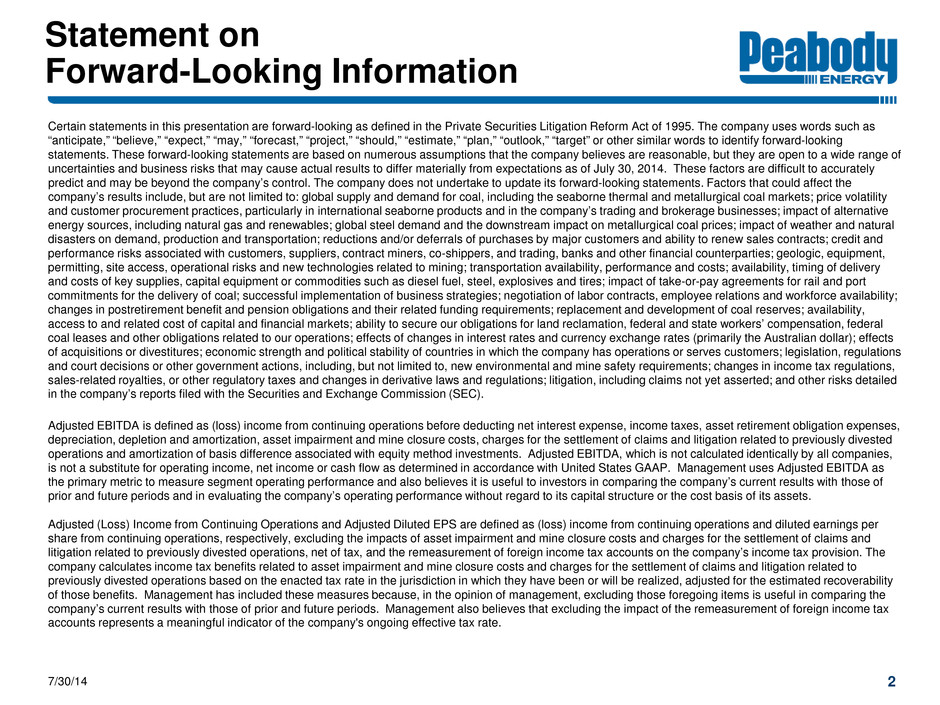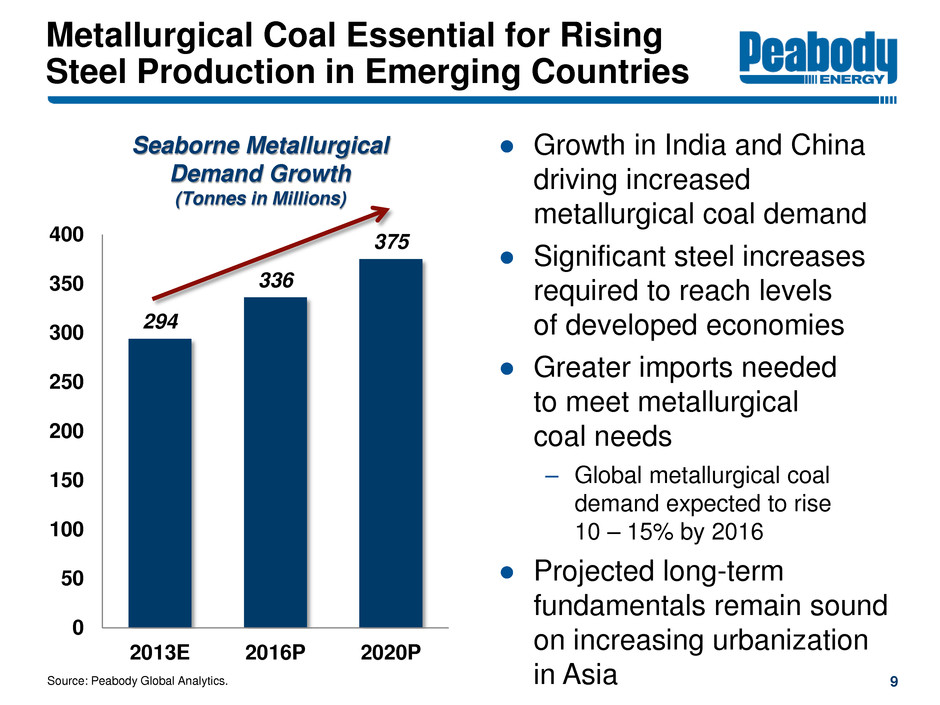Attached files
| file | filename |
|---|---|
| 8-K - FORM 8-K - PEABODY ENERGY CORP | btu_8-k20140730.htm |

July 30, 2014 Peabody Energy Investor Presentation Exhibit 99.1

Statement on Forward-Looking Information Certain statements in this presentation are forward-looking as defined in the Private Securities Litigation Reform Act of 1995. The company uses words such as “anticipate,” “believe,” “expect,” “may,” “forecast,” “project,” “should,” “estimate,” “plan,” “outlook,” “target” or other similar words to identify forward-looking statements. These forward-looking statements are based on numerous assumptions that the company believes are reasonable, but they are open to a wide range of uncertainties and business risks that may cause actual results to differ materially from expectations as of July 30, 2014. These factors are difficult to accurately predict and may be beyond the company’s control. The company does not undertake to update its forward-looking statements. Factors that could affect the company’s results include, but are not limited to: global supply and demand for coal, including the seaborne thermal and metallurgical coal markets; price volatility and customer procurement practices, particularly in international seaborne products and in the company’s trading and brokerage businesses; impact of alternative energy sources, including natural gas and renewables; global steel demand and the downstream impact on metallurgical coal prices; impact of weather and natural disasters on demand, production and transportation; reductions and/or deferrals of purchases by major customers and ability to renew sales contracts; credit and performance risks associated with customers, suppliers, contract miners, co-shippers, and trading, banks and other financial counterparties; geologic, equipment, permitting, site access, operational risks and new technologies related to mining; transportation availability, performance and costs; availability, timing of delivery and costs of key supplies, capital equipment or commodities such as diesel fuel, steel, explosives and tires; impact of take-or-pay agreements for rail and port commitments for the delivery of coal; successful implementation of business strategies; negotiation of labor contracts, employee relations and workforce availability; changes in postretirement benefit and pension obligations and their related funding requirements; replacement and development of coal reserves; availability, access to and related cost of capital and financial markets; ability to secure our obligations for land reclamation, federal and state workers’ compensation, federal coal leases and other obligations related to our operations; effects of changes in interest rates and currency exchange rates (primarily the Australian dollar); effects of acquisitions or divestitures; economic strength and political stability of countries in which the company has operations or serves customers; legislation, regulations and court decisions or other government actions, including, but not limited to, new environmental and mine safety requirements; changes in income tax regulations, sales-related royalties, or other regulatory taxes and changes in derivative laws and regulations; litigation, including claims not yet asserted; and other risks detailed in the company’s reports filed with the Securities and Exchange Commission (SEC). Adjusted EBITDA is defined as (loss) income from continuing operations before deducting net interest expense, income taxes, asset retirement obligation expenses, depreciation, depletion and amortization, asset impairment and mine closure costs, charges for the settlement of claims and litigation related to previously divested operations and amortization of basis difference associated with equity method investments. Adjusted EBITDA, which is not calculated identically by all companies, is not a substitute for operating income, net income or cash flow as determined in accordance with United States GAAP. Management uses Adjusted EBITDA as the primary metric to measure segment operating performance and also believes it is useful to investors in comparing the company’s current results with those of prior and future periods and in evaluating the company’s operating performance without regard to its capital structure or the cost basis of its assets. Adjusted (Loss) Income from Continuing Operations and Adjusted Diluted EPS are defined as (loss) income from continuing operations and diluted earnings per share from continuing operations, respectively, excluding the impacts of asset impairment and mine closure costs and charges for the settlement of claims and litigation related to previously divested operations, net of tax, and the remeasurement of foreign income tax accounts on the company’s income tax provision. The company calculates income tax benefits related to asset impairment and mine closure costs and charges for the settlement of claims and litigation related to previously divested operations based on the enacted tax rate in the jurisdiction in which they have been or will be realized, adjusted for the estimated recoverability of those benefits. Management has included these measures because, in the opinion of management, excluding those foregoing items is useful in comparing the company’s current results with those of prior and future periods. Management also believes that excluding the impact of the remeasurement of foreign income tax accounts represents a meaningful indicator of the company's ongoing effective tax rate. 7/30/14 2

Coal: World’s Fastest Growing Major Fuel; Expected to Be Largest Energy Source Rely on low-cost coal to fuel growing economies and raise standards of living 3 Emerging Countries Developed Countries U.S. Demand Long-Term Demand Returning to coal and adding new coal-fueled generation Coal remains largest and lowest-cost source of electricity generation in the U.S. Urbanization and industrialization trends expected to drive sustained long-term coal demand growth

Peabody Energy: Best Positioned Coal Company 4 Global Scope Superior Asset Base Low Cost U.S. Position Strong Metallurgical Coal Portfolio Competitive Advantage Proven Track Record Tier one assets in U.S. West, U.S. Midwest and Australia targeting highest-growth regions 8 billion tons of coal reserves and ~500,000 acres of surface land in U.S. and Australia Largest producer in Southern Powder River Basin with world’s most productive coal mine Largest seaborne low-vol PCI supplier and leading seaborne metallurgical coal presence Superior margins to peers; solid financial position and liquidity of $2.1 billion Active portfolio management; operational excellence; well-capitalized platform Reserves and acres of surface land based on 2013 10-K filing. Liquidity as of June 30, 2014.

Global Coal Markets 5

Expanding Global Energy Needs Lead to Rising Coal Demand 6 Global Coal Demand (MTOE) Global Energy Demand (MTOE) Global Electricity Use (TWh) 0 3,000 6,000 9,000 12,000 15,000 18,000 2010 2020P 2030P 0 6,000 12,000 18,000 24,000 30,000 36,000 2010 2020P 2030P 0 1,000 2,000 3,000 4,000 5,000 2010 2020P 2030P Source: Peabody Energy Analytics; International Energy Agency (IEA), 2013 World Energy Outlook (Current Policies Scenario). Energy and coal demand in Million Tonnes of Oil Equivalent (MTOE). Electricity use in terawatt-hours (TWh). +38% +69% +48%

Policies, Security and Economics Driving Greater Global Coal Use 7 United States Coal represents largest share of electricity generation at 41% Australia Repeals carbon tax in major policy reversal Europe Energy security crisis emphasizes advantage of coal Japan Supports development of advanced coal- fueled generation China Using technology and incentives to reduce emissions and increase coal use Source: Peabody Global Analytics. South Africa One of many nations addressing energy poverty with coal- fueled solutions Germany Targeting addition of 5.5 gigawatts of coal-fueled generation by 2015 India New PM pledges to make electricity available to every household by 2020

0 200 400 600 800 1,000 1,200 2013E 2016P 2020P New Generation Expected to Drive Significant Global Thermal Coal Demand ● New coal-fueled generation of ~250 GW projected by 2016 – Requires 750 million tonnes of new annual coal production at expected capacity utilization ● China and India imports likely to grow ~100 million tonnes in next three years 960 Projected Seaborne Thermal Coal Demand (Tonnes in Millions) 1,200 China Other Pacific India Atlantic Source: Peabody Global Analytics, McCloskey, other industry sources. 8 +85 +70 +115 -15 Coal to Account for 40% of Global Electricity Generation Growth 1,060

Metallurgical Coal Essential for Rising Steel Production in Emerging Countries Source: Peabody Global Analytics. 9 ● Growth in India and China driving increased metallurgical coal demand ● Significant steel increases required to reach levels of developed economies ● Greater imports needed to meet metallurgical coal needs – Global metallurgical coal demand expected to rise 10 – 15% by 2016 ● Projected long-term fundamentals remain sound on increasing urbanization in Asia 294 336 375 0 50 100 150 200 250 300 350 400 2013E 2016P 2020P Seaborne Metallurgical Demand Growth (Tonnes in Millions)

U.S. Coal Demand Increases; Fuels 41% of Electricity Generation in the U.S. Source: Peabody Global Analytics and EIA. YTD through June 2014. 10 31% 41% 31% 26% 19% 20% 19% 13% 0% 10% 20% 30% 40% 50% April 2012 June 2014 ● Coal use rebounds materially in the U.S. from 2012 lows ● Gas share reduced on rising natural gas prices ● Coal use up 6% YTD; gas generation down 2% ● Southern Powder River Basin and Illinois Basin coal very competitive with natural gas – SPRB: $2.50 – $2.75 – ILB: $3.50 – $3.75 – CAPP: $4.50+ Share of U.S. Electric Power Sector Generation C oa l N at ur al G as N uc le ar Ot he r

SPRB Inventories ~45% Below 2012 Peak Levels ● SPRB stockpiles below normal at 49 days use ● Rail performance, coal conservation measures and mild summer suppress coal burn ● Total U.S. coal demand expected to increase 30 to 40 million tons in 2014 Source: Peabody Global Analytics and EIA. Stockpiles as of July 28, 2014. 11 SPRB Utility Inventories (Days Use) - 10 20 30 40 50 60 70 80 90 June 2012 Sept. 2012 Dec. 2012 Mar. 2013 June 2013 Sept. 2013 Dec. 2013 Mar. 2014 June 2014 Inventories ~45% below 2012 peak levels

Source: Peabody Global Analytics. SPRB and Illinois Basin: 75 Million Ton Demand Increase Forecast by 2016 Expected SPRB and ILB Generation Demand (Tons in Millions) +35 0 200 400 600 2013 Retirements Utilization Switching 2016P -55 +30 510 585 12 +100 SPRB and ILB +75 ● Significant coal-fueled generation of ~250 GW projected to remain on line in 2016 ● Increased power plant utilization and basin switching expected to more than offset retirements – Current coal fleet utilization ~60% of capacity, remaining fleet expected to run over 70% by 2016

0 2,000 4,000 6,000 8,000 10,000 2013E 2016P 2020P ROW China India Annual World Coal Use Expected to Grow 600 Million Tonnes Over Next Three Years ● Coal is the world’s fastest growing major fuel ● Global coal market share increases to 30% of energy consumption; greatest contribution to energy mix since 1970 ● IEA and other observers project that coal will overtake oil as world’s largest energy source in coming years Source: Peabody Global Analytics. Global coal market share as of 2013 per BP Statistical Review. Expected Global Coal Demand (Tonnes in Millions) 2,905 3,030 4,460 4,140 890 760 7,805 8,380 13 9,165 1,070 4,910 3,185

Peabody Energy Overview 14

Peabody’s U.S. Operations Focused on Maximizing Margins 15 ● Improving cost profile – U.S. productivity increases 11% in first half of 2014 compared to prior year period – U.S. costs per ton expected to be 1 to 3 percent below 2013 levels ● Targeting U.S. sales of 185 to 190 million tons in 2014 – 2014 projected U.S. sales volumes are essentially fully priced with 2015 sales 20 to 30 percent unpriced based on comparable 2014 production levels – 2014 U.S. revenues per ton expected to be 4 to 7 percent below 2013 levels Unpriced position as of June 30, 2014.

Australian Productivity Increases 35% in First Half of 2014 ● Longwalls commissioned at North Goonyella and Metropolitan mines ● Successful owner-operator conversion initiative with expected completion of Moorvale PCI Mine in the third quarter ● Wilpinjong Mine: 13 million tons per year; among lowest cost coal mines in Australia ● Wambo Mine provides high-quality, low-ash thermal export coal ● 35 to 37 million tons of coal sales – 16 to 17 million tons of metallurgical coal – 11 to 12 million tons of seaborne thermal coal ● Average costs in the low-mid $70s per ton 16 Metallurgical Coal Operations Thermal Coal Operations 2014 Targets First half 2014 productivity improvements compared to prior-year period. 30, 2014.

Well-Capitalized Platform Allows Low Capital Spending for Multiple Years 17 ● First half 2014 capital expenditures total $65 million ● Capex reduced 67% in 2013; 2014 capex target of $210 to $250 million ● Sustaining capital trending below historical range of $1.25 to $1.75/ton • Completed SPRB Recapitalization • Completed Mine Development in Midwest and Southwest U.S. Projects • Largely Completed Owner- Operator Conversions in Australia • Completed Multiple Australian Mine Expansions Australia Projects Major Investments in U.S. and Australia in Recent Years

Peabody’s Core Strengths Targeted to Long-Term Value Creation 18 Superior Asset Base • Leading reserve position • Geographic diversity • Access to high growth regions • Leading presence in SPRB and ILB Best-In- Class Operations • Continuous focus on safety • Strong operating performance • Technology- driven process improvements • Aggressive cost containment Solid Financial Position • Well-capitalized platform • $2.1 billion of liquidity • No significant near-term debt maturities • Opportunistic sales of non- core assets Major Growth Potential • Long-term expansion opportunities • Asian partnerships and joint ventures • Thought leader in sustainable mining, energy access and clean coal solutions Liquidity as of June 30, 2014.

PeabodyEnergy.com AdvancedEnergyForLife.com

Appendix: Reconciliation of Non-GAAP Measures 7/30/14 20 This information is intended to be reviewed in conjunction with the company’s filings with the Securities and Exchange Commission. (Dollars in millions, except per share data) Mar. 31 Jun. 30 2014 (1) 2014 (1) Low (2) High (2) 2013 (1) 2012 (1) Adjusted EBITDA (3) 176.9$ 213.1$ 140$ 190$ 1,047.2$ 1,836.5$ Depreciation, depletion and amortization 157.2 163.1 160 170 740.3 663.4 Asset retirement obligation expenses 15.6 15.9 21 19 66.5 67.0 Amortization of basis difference related to equity affiliates 1.2 1.3 - - 6.3 4.6 Interest income (3.6) (4.4) (2) (3) (15.7) (24.5) Interest expense 103.3 103.6 105 103 408.3 402.3 Debt modification or extinguishment charges - 1.6 - - 16.9 3.3 Income tax (benefit) provision, excluding tax items shown separately below (51.1) 5.3 - 5 (279.9) 481.7 Adjusted (Loss) Income from Continuing Operations (3) (45.7)$ (73.3)$ (144)$ (104)$ 104.5$ 238.7$ Asset impairment and mine closure costs - - - - 528.3 929.0 Settlement charges related to the Patriot bankrupty reorganization - - - - 30.6 - Tax benefit related to asset impairment and mine closure costs - - - - (112.8) (227.3) Tax benefit related to settlement charges related to the Patriot bankruptcy reorganization - - - - (11.3) - Remeasurement (benefit) expense related to foreign income tax accounts (1.4) (1.3) - - (44.3) 7.9 Loss from continuing operations, net of income taxes (44.3)$ (72.0)$ (144)$ (104)$ (286.0)$ (470.9)$ Diluted EPS - Loss from continuing operations (0.18)$ (0.28)$ (0.53)$ (0.40)$ (1.12)$ (1.80)$ Asset impairment and mine closure costs, net of income taxes - - - - 1.56 2.61 Settlement charges related to the Patriot bankruptcy reorganization, net of income taxes - - - - 0.07 - Remeasurement (benefit) expense related to foreign income tax accounts (0.01) - - - (0.17) 0.03 Adjusted Diluted EPS (3) (0.19)$ (0.28)$ (0.53)$ (0.40)$ 0.34$ 0.84$ (1) Actual historical results. (2) Range of targeted projected results. (3) Non-GAAP financial measure defined on slide 2 of this presentation. Year Ended Dec. 31, Reconciliation of Non-GAAP Financial Measures (Unaudited) Sept. 30, 2014 Quarter Ended
